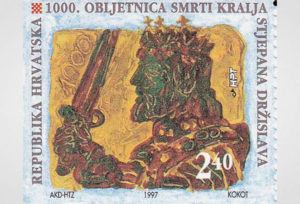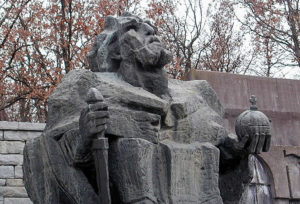 The unresolved matter of succession of the throne was not only one of the key questions, but also posed as a potential threat. In fact, in Croatian Kingdom there was no principle whatsoever that would clearly determine who was to rule after King’s death. The first attempt to resolve this issue dates back to Stjepan Držislav. On two stone tablets from his time there is a mention of a certain dux magnus, most probably Svetoslav, his eldest(?) son. On the first tablet there is an inscription stating: CLV DUX HROATOR[UM] IN TE[M]PUS DUCE[M] MAGNU[M], and in the other tablet it continues thus: IRZICLV DUCE[M] MAGNU[M].1 Since in epitaphs rulers were traditionally titled rex, one can conclude that, at the time of composition of the inscription from Kapitul near Knin, Držislav was the rightful heir to the throne, and he was also accompanied by a certain duke. Another possibility was an assumption that Držislav remained uncrowned, and that the duke was his heir. Anyhow, we can say with certainty that the Kapitul inscription shows that, at the time, there was a strictly determined hierarchy that regulated the question of succession. Another important fact about this inscription is that it shows that one of the centers of the Kingdom at that time was Knin.2
The unresolved matter of succession of the throne was not only one of the key questions, but also posed as a potential threat. In fact, in Croatian Kingdom there was no principle whatsoever that would clearly determine who was to rule after King’s death. The first attempt to resolve this issue dates back to Stjepan Držislav. On two stone tablets from his time there is a mention of a certain dux magnus, most probably Svetoslav, his eldest(?) son. On the first tablet there is an inscription stating: CLV DUX HROATOR[UM] IN TE[M]PUS DUCE[M] MAGNU[M], and in the other tablet it continues thus: IRZICLV DUCE[M] MAGNU[M].1 Since in epitaphs rulers were traditionally titled rex, one can conclude that, at the time of composition of the inscription from Kapitul near Knin, Držislav was the rightful heir to the throne, and he was also accompanied by a certain duke. Another possibility was an assumption that Držislav remained uncrowned, and that the duke was his heir. Anyhow, we can say with certainty that the Kapitul inscription shows that, at the time, there was a strictly determined hierarchy that regulated the question of succession. Another important fact about this inscription is that it shows that one of the centers of the Kingdom at that time was Knin.2
 Having received a consolidated state to rule, Držislav was able to start an active external policy once again. Since Croatia was ecclesiastically in close relation to the imperial Dalmatia, including the Croatian parishes, Držislav, like Tomislav, restored good relationship to Byzantium by joining an alliance against then very powerful Bulgarian-Macedonian ruler Samuilo.3 In fact, Bulgaria had not only risen from ashes and, under Samuilo’s reign, fought its independence, but it had also spread its government to Serbia, Bosnia and Srijem, as well as the whole of Adriatic coast south of river Cetina, by conquering Duklja. Samuilo was also successful in some European Byzantine territories, thus that emperor ruled over a gigantic area spreading to the borders of former Simeon’s Bulgaria. During the Bulgarian-Byzantine war, Emperor Samuilo persecuted some of his own relatives, who found refuge in Croatia, where King Držislav welcomed them hospitably.4
Having received a consolidated state to rule, Držislav was able to start an active external policy once again. Since Croatia was ecclesiastically in close relation to the imperial Dalmatia, including the Croatian parishes, Držislav, like Tomislav, restored good relationship to Byzantium by joining an alliance against then very powerful Bulgarian-Macedonian ruler Samuilo.3 In fact, Bulgaria had not only risen from ashes and, under Samuilo’s reign, fought its independence, but it had also spread its government to Serbia, Bosnia and Srijem, as well as the whole of Adriatic coast south of river Cetina, by conquering Duklja. Samuilo was also successful in some European Byzantine territories, thus that emperor ruled over a gigantic area spreading to the borders of former Simeon’s Bulgaria. During the Bulgarian-Byzantine war, Emperor Samuilo persecuted some of his own relatives, who found refuge in Croatia, where King Držislav welcomed them hospitably.4
Držislav’s support to Byzantine emperor was of extreme importance to Byzantium, which is the main reason that Emperor Basil II Bulgar-slayer (976-1025) gave him jurisdiction over Dalmatia. Furthermore, Držislav received from Constantinople the royal insignia, as well as titles of eparchy and patrician. After receiving these titles, Croatian ruler is also mentioned as Stjepan, which made him the first king of Croatia with a formal confirmation from Byzantium. There is also an information coming from Toma the Archdeacon that from the time of Stjepan Držislav onwards his successors were called kings of Croatia and Dalmatia.5
 Just before Stjepan Držislav’s reign was about to end, Venetian doge Pietro Orseolo (991-1009), encouraged by good relations to the newly formed Holy Roman Empire, but also to the Byzantine Empire, decided to stop paying the usual tax to Croatians and Neretvanians. When Stjepan Držislav found out about this decision, he gave an order Venetians would be treated as enemies, thus after more than a hundred years of peace Croatia and Venice were in conflict once again. Venetians, under the command of Badoari Bragadin, defeated Croatians in a battle near the island of Vis, and then scourged a pirate base of Lastovo.6
Just before Stjepan Držislav’s reign was about to end, Venetian doge Pietro Orseolo (991-1009), encouraged by good relations to the newly formed Holy Roman Empire, but also to the Byzantine Empire, decided to stop paying the usual tax to Croatians and Neretvanians. When Stjepan Držislav found out about this decision, he gave an order Venetians would be treated as enemies, thus after more than a hundred years of peace Croatia and Venice were in conflict once again. Venetians, under the command of Badoari Bragadin, defeated Croatians in a battle near the island of Vis, and then scourged a pirate base of Lastovo.6
Držislav died around 997, after having appointed his eldest son Svetoslav, called Suronja, as his coruler and successor. Despite the attempt to organize hereditary politics, Croatia was, like many other European states, struck by political split. Two younger sons of Držislav, Krešimir and Gojislav were unsatisfied with their father’s decision, so they rose against Svetoslav.7 Encouraged by their successes against Byzantium and spreading their government to Greek lands, the Bulgarians were looking to secure their western borders as well, which meant another attack on Croatia, and also the Byzantine cities along the Adriatic sea. The central Samuilo’s goal was Zadar, but the conquest failed. Strong city walls of Zadar, Trogir and Split haven’t yielded, so the Bulgarian-Macedonian army withdrew with their job left unfinished.8
Other articles from the series: “The Trpimirović Dynasty of Croatian Rulers”
- From the Arrival and Settling of Croats to Trpimir Ascending to the Throne
- The age of duke Trpimir
- Dukes Domagoj and Zdeslav
- Branimir and Muncimir
- The age of kings – Tomislav
- Church Councils and King Tomislav’s Heirs
- Stjepan Držislav
- The Heirs of Stjepan Držislav
- Petar Krešimir IV
- Demetrius Zvonimir
- Demetrius Zvonimir and Stephen II
- By restoring good relations and partaking in alliance against the Bulgarians, Držislav received from the Byzantine emperor the titles of eparchy and patrician, as well as royal insignia, and from then on he appears under the name of Stjepan. Stjepan Držislav was the first Croatian king ever to be officially confirmed by Byzantium.
- Encouraged by the spreading of their own territory to the borders of former Simeon’s state, as well as successful campaign against Byzantium, the Bulgarian-Macedonian war expedition invaded Croatia, in order to secure their western borders. However, strong city walls of Zadar, Split and Trogir successfully repelled the Bulgarian attack, thus the main goal of the conquest remained unachieved.
- Neven BUDAK, Prva stoljeća Hrvatske, Zagreb: Hrvatska sveučilišna naklada, 1994.
- Stjepan GUNJAČA, Ispravci i dopune, Book II., Zagreb: Školska knjiga, 1973 – 1975.
- Tomislav RAUKAR, Hrvatsko srednjovjekovlje, Zagreb: Školska knjiga, 1997
- Tadija SMIČIKLAS, Poviest hrvatska, volume one, Zagreb: Matica hrvatska, 1882
- Ferdo ŠIŠIĆ, Povijest Hrvata u vrijeme narodnih vladara, Zagreb: Nakladni zavod Matice hrvatske, 1925.
- 1 Tomislav RAUKAR, Hrvatsko srednjovjekovlje, Zagreb: Školska knjiga, 1997, p. 41
- 2 Neven BUDAK, Prva stoljeća Hrvatske…, p. 35
- 3 Ferdo ŠIŠIĆ, Povijest Hrvata u vrijeme narodnih vladara, Zagreb: Hrvatska sveučilišna naklada, 1994, p. 468
- 4 Pintius, one of the exiles, constructed a church of St. Michael in Solin in 994; Tadija SMIČIKLAS, Poviest hrvatska, volume one, Zagreb: Matica hrvatska, 1882, p. 230 Details on the problem of Pintius’ document authenticity can be found in: Stjepan GUNJAČA, Ispravci i dopune, vol. II, Zagreb: Školska knjiga, 1973, p. 271-338
- 5 BUDAK, Prva stoljeća Hrvatske…, p. 35-36
- 6 ŠIŠIĆ, Povijest Hrvata u vrijeme narodnih vladara …, p. 470
- 7 A completely different interpretation of the relations within the dinasty and fight for power is given in: GUNJAČA, Ispravci i dopune…, vol. II, p. 347-409
- 8 ŠIŠIĆ, Povijest Hrvata u vrijeme narodnih vladara…, p. 468
Your comment